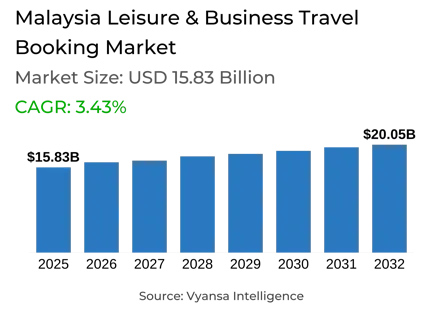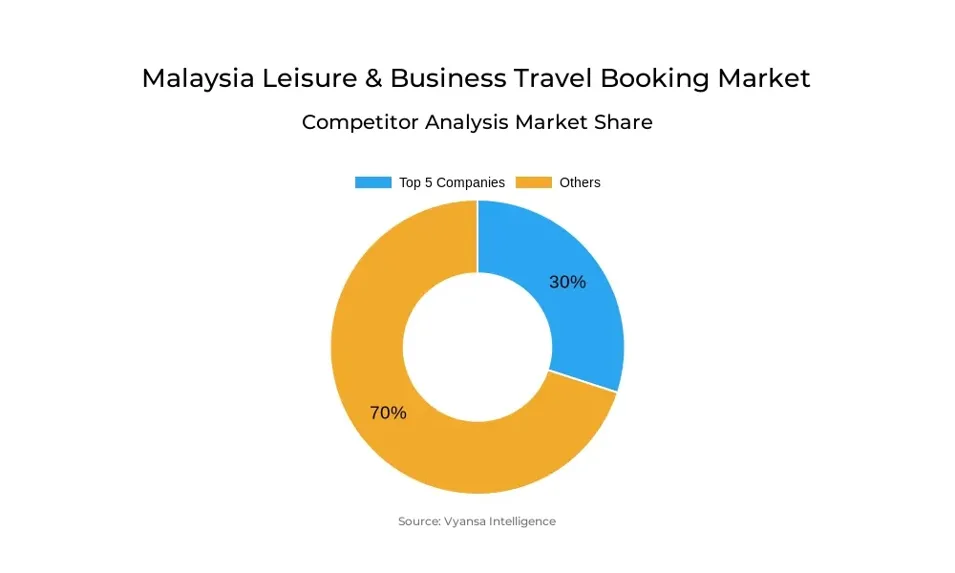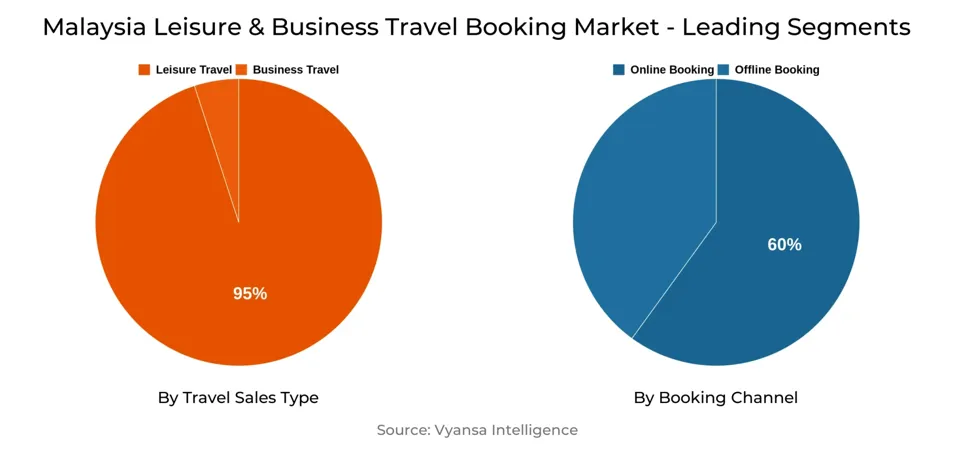
Malaysia Leisure & Business Travel Booking Market Report: Trends, Growth and Forecast (2026-2032)
By Travel Sales Type (Leisure Travel, Business Travel), By Booking Channel (Offline Booking, Online Booking), By Booking Method (Travel Intermediaries, Direct Suppliers)
- ICT
- Nov 2025
- VI0396
- 130
-




Malaysia Leisure & Business Travel Booking Market Statistics and Insights, 2026
- Market Size Statistics
- Leisure & Business Travel Booking in Malaysia is estimated at $ 15.83 Billion.
- The market size is expected to grow to $ 20.05 Billion by 2032.
- Market to register a CAGR of around 3.43% during 2026-32.
- Travel Sales Type Shares
- Leisure Travel grabbed market share of 95%.
- Competition
- Malaysia Leisure & Business Travel Booking Market is currently being catered to by more than 15 companies.
- Top 5 companies acquired 30% of the market share.
- Klook Travel Technology Ltd, Trinusa Travelindo PT, Trip.com Group Ltd, Capital A Bhd, Agoda International (M) Sdn Bhd etc., are few of the top companies.
- Booking Channel
- Online Booking grabbed 60% of the market.
Malaysia Leisure & Business Travel Booking Market Outlook
Malaysia leisure and business travel booking market was worth $15.83 billion in 2025 and is forecasted to grow to $20.05 billion by 2032. Growth arises from Malaysias' growing need to travel both domestically and abroad as borders reopened post-pandemic. Online booking channels dominate the market, capturing 60% share, with mobile apps and platforms like AirAsia MOVE leading the shift. These apps offer integrated services such as flight, hotel, bus, train, and ferry bookings, along with rewards programs, fintech services, and 24/7 support, creating a seamless, personalised experience for digitally savvy travellers.
Increased demand for unique and personalized experiences is influencing booking behavior, with travelers looking to engage in local culture and experience novel activities. Intermediaries online are teaming up with e-commerce sites to provide compelling bundles and off-season promotions, and encouraging consumption and adoption further. Offline intermediaries, meanwhile, remain relevant through trust, personalized advice, and complex itinerary support, especially for senior travelers and multi-destination travelers.
Government policies, like SME digitalisation grants and the National Tourism Policy, are stimulating traditional intermediaries to develop online abilities while sustaining support for domestic and inbound tourism. Travel agencies diversify their product offerings to encompass eco-tourism and sustainable travel packages that promote local communities and complement increased end user demand for responsible tourism.
The period of the forecast will witness more innovation in mobile and AI-driven booking experiences, loyalty schemes, and personalised recommendations. Those travel intermediaries that succeed in balancing digital convenience with individualised service are set to increase their share of the Malaysia market, fuelling continued growth in both leisure and business travel bookings.

Malaysia Leisure & Business Travel Booking Market Growth Driver
Increasing Demand for Unique Travel Experiences
The Malaysia tourism market is fuelled by an increasing need for unique and bespoke experiences. Travelers are looking for more than the usual sightseeing and seeking experiences to engage in local cultures, experience special activities, and indulge in luxury or bespoke holidays. This overwhelming preference prompts travel intermediaries to create and innovate packaged holidays that meet these changing tastes.
This driver also emphasizes the attraction of sustainable and community-based tourism. Tourists are more aware of experiences that sustain local communities and consume fewer environmental assets. Therefore, travel suppliers in Malaysia are encouraged to create offerings that not only fulfill the need for experiential moments but also do good for the environment and society.
Malaysia Leisure & Business Travel Booking Market Trend
Growth of Mobile and Lifestyle Platforms
The Malaysia travel environment is experiencing a robust trend of effortless mobile booking experiences. Applications like AirAsia MOVE are rewriting the rulebook on how travelers plan, book, and organize trips by combining flights, hotels, transport, restaurants, and even lifestyle services on one platform. This is an indication of the wider shift towards convenience and comprehensive digital experiences in tourism.
Younger, more digitally attuned end users are turning more and more to mobile platforms to seek out travel solutions, shop around for prices, and book with ease. Travel intermediaries are meeting the challenge by improving their online services and embedding loyalty schemes, AI-driven recommendations, and value-added services to satisfy these changing tastes, making mobile platforms a vital element of the market's development.
Malaysia Leisure & Business Travel Booking Market Opportunity
Increasing Potential in E-Commerce Partnerships
Malaysia travel intermediaries are offered the chance to collaborate with leading e-commerce portals to provide competitive travel packages and promotions. These partnerships allow players to reach a significant, digitally savvy base and offer new-value propositions that merge convenience with savings, thus improving end user interaction and stimulating bookings.
These collaborations also create opportunities for seasonal promotions and thoughtful offers that resonate with various segments of end users. Travel intermediaries can gain wider reach, attract younger travelers, and drive domestic and foreign tourism by utilizing e-commerce platforms, making this a major opportunity for long-term market expansion.
Malaysia Leisure & Business Travel Booking Market Segmentation Analysis

By Travel Sales Type
- Leisure Travel
- Business Travel
The segment with highest market share under Travel Sales Type is Leisure Travel, commanding 95% of the market. Malaysia leisure travellers have a keen interest in both domestic and international tourism, wanting unique and individualized experiences. They opt for those which enable them to engage with local culture, experience novel activities, and indulge in high-end offerings such as mini-trips with luxury accommodations, private drivers, and custom-designed experiences.
Leisure Travel remains to gain from increased emphasis on sustainable and nature-based tourism, benefiting local communities in addition to providing enriching experiences. Travelers are more focused on convenience and hassle-free service with many employing digital tools for planning and organizing their trips. The segment's strong growth is based on its vast preferences and openness to trying new experiences, hence being the main engine of travel reservations in Malaysia
By Booking Channel
- Offline Booking
- Online Booking
The segment with highest market share under Booking Channel, with a market share of 60%, is Online Booking. Malaysias, especially young end users, like to book travel online because it is easy to compare prices, read reviews, and get customized packages. Online providers also provide integrated services so that travelers can book flights, accommodations, car rentals, and even restaurants from one app, providing a seamless travel experience.
Digitalization continues to influence the market, with travel apps like AirAsia MOVE providing loyalty programs, AI-driven recommendations, and rewards to help drive engagement. Coupled with collaboration with e-commerce sites, it further enhances the attractiveness of online bookings through compelling promotions and bundled products. The ease, speed, and tailored choices of online media make them the go-to option for most travelers, driving long-term growth for Malaysia travel booking Market.
Top Companies in Malaysia Leisure & Business Travel Booking Market
The top companies operating in the market include Klook Travel Technology Ltd, Trinusa Travelindo PT, Trip.com Group Ltd, Capital A Bhd, Agoda International (M) Sdn Bhd, Booking.com BV, Expedia Group Inc, Mayflower Acme Tours Sdn Bhd, Avillion Bhd, PST Travel Services Sdn Bhd, etc., are the top players operating in the Malaysia Leisure & Business Travel Booking Market.
Frequently Asked Questions
Related Report
1. Market Segmentation
1.1. Research Scope
1.2. Research Methodology
1.3. Definitions and Assumptions
2. Executive Summary
3. Malaysia Leisure & Business Travel Booking Market Policies, Regulations, and Standards
4. Malaysia Leisure & Business Travel Booking Market Dynamics
4.1. Growth Factors
4.2. Challenges
4.3. Trends
4.4. Opportunities
5. Malaysia Leisure & Business Travel Booking Market Statistics, 2022-2032F
5.1. Market Size & Growth Outlook
5.1.1. By Revenues in US$ Million
5.2. Market Segmentation & Growth Outlook
5.2.1. By Travel Sales Type
5.2.1.1. Leisure Travel- Market Insights and Forecast 2022-2032, USD Million
5.2.1.2. Business Travel- Market Insights and Forecast 2022-2032, USD Million
5.2.2. By Booking Channel
5.2.2.1. Offline Booking- Market Insights and Forecast 2022-2032, USD Million
5.2.2.2. Online Booking- Market Insights and Forecast 2022-2032, USD Million
5.2.3. By Booking Method
5.2.3.1. Travel Intermediaries- Market Insights and Forecast 2022-2032, USD Million
5.2.3.2. Direct Suppliers- Market Insights and Forecast 2022-2032, USD Million
5.2.4. By Competitors
5.2.4.1. Competition Characteristics
5.2.4.2. Market Share & Analysis
6. Malaysia Leisure Travel Booking Market Statistics, 2022-2032F
6.1. Market Size & Growth Outlook
6.1.1. By Revenues in US$ Million
6.2. Market Segmentation & Growth Outlook
6.2.1. By Travel Sales Type- Market Insights and Forecast 2022-2032, USD Million
6.2.1.1. Leisure Air Travel- Market Insights and Forecast 2022-2032, USD Million
6.2.1.2. Leisure Car Rental- Market Insights and Forecast 2022-2032, USD Million
6.2.1.3. Leisure Cruise- Market Insights and Forecast 2022-2032, USD Million
6.2.1.4. Leisure Experiences and Attractions- Market Insights and Forecast 2022-2032, USD Million
6.2.1.5. Leisure Lodging- Market Insights and Forecast 2022-2032, USD Million
6.2.2. By Booking Channel- Market Insights and Forecast 2022-2032, USD Million
6.2.3. By Booking Method- Market Insights and Forecast 2022-2032, USD Million
7. Malaysia Business Travel Booking Market Statistics, 2022-2032F
7.1. Market Size & Growth Outlook
7.1.1. By Revenues in US$ Million
7.2. Market Segmentation & Growth Outlook
7.2.1. By Travel Sales Type- Market Insights and Forecast 2022-2032, USD Million
7.2.1.1. Business Air Travel- Market Insights and Forecast 2022-2032, USD Million
7.2.1.2. Business Car Rental- Market Insights and Forecast 2022-2032, USD Million
7.2.1.3. Business Lodging- Market Insights and Forecast 2022-2032, USD Million
7.2.1.4. Others- Market Insights and Forecast 2022-2032, USD Million
7.2.2. By Booking Channel- Market Insights and Forecast 2022-2032, USD Million
7.2.3. By Booking Method- Market Insights and Forecast 2022-2032, USD Million
8. Competitive Outlook
8.1. Company Profiles
8.1.1. Capital A Bhd
8.1.1.1. Business Description
8.1.1.2. Service Portfolio
8.1.1.3. Collaborations & Alliances
8.1.1.4. Recent Developments
8.1.1.5. Financial Details
8.1.1.6. Others
8.1.2. Agoda International (M) Sdn Bhd
8.1.2.1. Business Description
8.1.2.2. Service Portfolio
8.1.2.3. Collaborations & Alliances
8.1.2.4. Recent Developments
8.1.2.5. Financial Details
8.1.2.6. Others
8.1.3. Booking.com BV
8.1.3.1. Business Description
8.1.3.2. Service Portfolio
8.1.3.3. Collaborations & Alliances
8.1.3.4. Recent Developments
8.1.3.5. Financial Details
8.1.3.6. Others
8.1.4. Expedia Group Inc
8.1.4.1. Business Description
8.1.4.2. Service Portfolio
8.1.4.3. Collaborations & Alliances
8.1.4.4. Recent Developments
8.1.4.5. Financial Details
8.1.4.6. Others
8.1.5. Mayflower Acme Tours Sdn Bhd
8.1.5.1. Business Description
8.1.5.2. Service Portfolio
8.1.5.3. Collaborations & Alliances
8.1.5.4. Recent Developments
8.1.5.5. Financial Details
8.1.5.6. Others
8.1.6. Klook Travel Technology Ltd
8.1.6.1. Business Description
8.1.6.2. Service Portfolio
8.1.6.3. Collaborations & Alliances
8.1.6.4. Recent Developments
8.1.6.5. Financial Details
8.1.6.6. Others
8.1.7. Trinusa Travelindo PT
8.1.7.1. Business Description
8.1.7.2. Service Portfolio
8.1.7.3. Collaborations & Alliances
8.1.7.4. Recent Developments
8.1.7.5. Financial Details
8.1.7.6. Others
8.1.8. Trip.com Group Ltd
8.1.8.1. Business Description
8.1.8.2. Service Portfolio
8.1.8.3. Collaborations & Alliances
8.1.8.4. Recent Developments
8.1.8.5. Financial Details
8.1.8.6. Others
8.1.9. Avillion Bhd
8.1.9.1. Business Description
8.1.9.2. Service Portfolio
8.1.9.3. Collaborations & Alliances
8.1.9.4. Recent Developments
8.1.9.5. Financial Details
8.1.9.6. Others
8.1.10. PST Travel Services Sdn Bhd
8.1.10.1. Business Description
8.1.10.2. Service Portfolio
8.1.10.3. Collaborations & Alliances
8.1.10.4. Recent Developments
8.1.10.5. Financial Details
8.1.10.6. Others
9. Disclaimer
| Segment | Sub-Segment |
|---|---|
| By Travel Sales Type |
|
| By Booking Channel |
|
| By Booking Method |
|
Research Methodology
This study followed a structured approach comprising four key phases to assess the size and scope of the electro-oxidation market. The process began with thorough secondary research to collect data on the target market, related markets, and broader industry context. These findings, along with preliminary assumptions and estimates, were then validated through extensive primary research involving industry experts from across the value chain. To calculate the overall market size, both top-down and bottom-up methodologies were employed. Finally, market segmentation and data triangulation techniques were applied to refine and validate segment-level estimations.
Secondary Research
The secondary research phase involved gathering data from a wide range of credible and published sources. This step helped in identifying industry trends, defining market segmentation, and understanding the market landscape and value chain.
Sources consulted during this phase included:
- Company annual reports, investor presentations, and press releases
- Industry white papers and certified publications
- Trade directories and market-recognized databases
- Articles from authoritative authors and reputable journals
- Gold and silver standard websites
Secondary research was critical in mapping out the industry's value chain and monetary flow, identifying key market segments, understanding regional variations, and tracking significant industry developments.
Other key sources:
- Financial disclosures
- Industry associations and trade bodies
- News outlets and business magazines
- Academic journals and research studies
- Paid industry databases
Primary Research
To validate secondary data and gain deeper market insights, primary research was conducted with key stakeholders across both the supply and demand sides of the market.
On the demand side, participants included decision-makers and influencers from end-user industries—such as CIOs, CTOs, and CSOs—who provided first-hand perspectives on market needs, product usage, and future expectations.
On the supply side, interviews were conducted with manufacturers, industry associations, and institutional participants to gather insights into current offerings, product pipelines, and market challenges.
Primary interviews provided critical inputs such as:
- Market size and revenue data
- Product and service breakdowns
- Market forecasts
- Regional and application-specific trends
Stakeholders consulted included:
- Leading OEM and solution providers
- Channel and distribution partners
- End users across various applications
- Independent consultants and industry specialists
Market Size Estimation and Data Triangulation
- Identifying Key Market Participants (Secondary Research)
- Goal: To identify the major players or companies in the target market. This typically involves using publicly available data sources such as industry reports, market research publications, and financial statements of companies.
- Tools: Reports from firms like Gartner, Forrester, Euromonitor, Statista, IBISWorld, and others. Public financial statements, news articles, and press releases from top market players.
- Extracting Earnings of Key Market Participants
- Goal: To estimate the earnings generated from the product or service being analyzed. This step helps in understanding the revenue potential of each market player in a specific geography.
- Methods: Earnings data can be gathered from:
- Publicly available financial reports (for listed companies).
- Interviews and primary data sources from professionals, such as Directors, VPs, SVPs, etc. This is especially useful for understanding more nuanced, internal data that isn't publicly disclosed.
- Annual reports and investor presentations of key players.
- Data Collation and Development of a Relevant Data Model
- Goal: To collate inputs from both primary and secondary sources into a structured, data-driven model for market estimation. This model will incorporate key market KPIs and any independent variables relevant to the market.
- Key KPIs: These could include:
- Market size, growth rate, and demand drivers.
- Industry-specific metrics like market share, average revenue per customer (ARPC), or average deal size.
- External variables, such as economic growth rates, inflation rates, or commodity prices, that could affect the market.
- Data Modeling: Based on this data, the market forecasts are developed for the next 5 years. A combination of trend analysis, scenario modeling, and statistical regression might be used to generate projections.
- Scenario Analysis
- Goal: To test different assumptions and validate how sensitive the market is to changes in key variables (e.g., market demand, regulatory changes, technological disruptions).
- Types of Scenarios:
- Base Case: Based on current assumptions and historical data.
- Best-Case Scenario: Assuming favorable market conditions, regulatory environments, and technological advancements.
- Worst-Case Scenario: Accounting for adverse factors, such as economic downturns, stricter regulations, or unexpected disruptions.
Partnering With Industry Leaders to Drive Growth
Our mission is to deliver intelligence that matters. By combining data, analysis, and industry expertise, we enable organizations to make smarter, faster, and more impactful decisions. Whether it’s a Fortune 500 company or a high-growth startup, businesses trust us to provide clarity in an ever-evolving marketplace.






